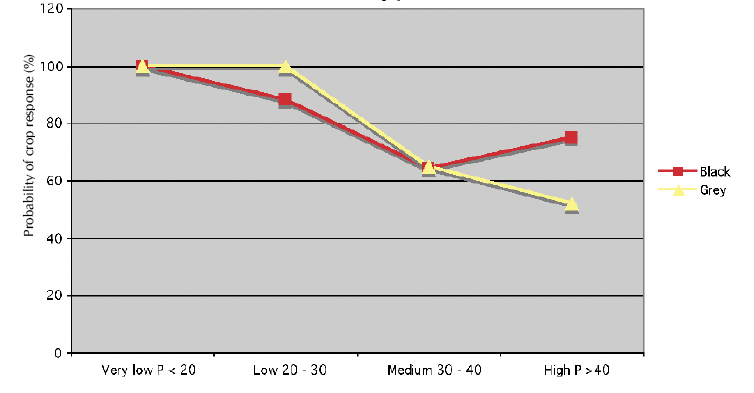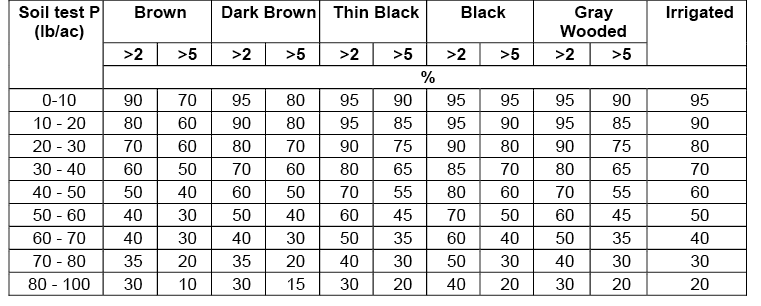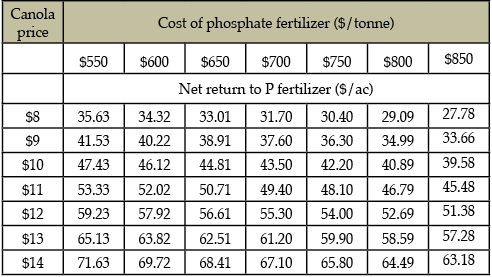
Features
Agronomy
Fertility and Nutrients
How much phosphate does canola need?
How can a grower determine if he is a gambler? Well, farming is inherently a gamble, but playing the percentages is a proven strategy for minimizing the risks, and it also helps in developing phosphate (P) fertility plans.
February 4, 2010 By Bruce Barker
 |
|
| High yielding canola requires lots of P. Price dictates how much a grower can afford to put on. Photo by Bruce Barker. |
How can a grower determine if he is a gambler? Well, farming is inherently a gamble, but playing the percentages is a proven strategy for minimizing the risks, and it also helps in developing phosphate (P) fertility plans. “For a starting point for farmers, if you soil test, it goes a long way to helping decide if you should be fertilizing and by how much,” says Dr. Ross McKenzie, research agronomist with Alberta Agriculture and Rural Development (AARD) at Lethbridge. “A soil test won’t tell you exactly how much P you have in the soil, but at least you can determine if you are in a deficient zone, a marginal zone or an adequate zone for phosphorus.”
McKenzie says soil tests are accurate, and believes that the best approach uses a zero- to six-inch sample depth at 20 random locations in a field. Eroded soil areas or low yielding areas within a field should be sampled separately. The modified Kelowna soil test method is recommended for Western Canada as it is well correlated to P responses, and he adds that if a grower’s particular lab is not using it, he should consider changing to a different lab that does.
Predicting whether a canola crop will respond to P fertilizer is most successful when the fertility plan is based on a soil test. The generally accepted level where P deficiency occurs is in the 0 to 30 lbs of P2O5 per acre range.
“When you look at all the work we’ve done across the province, we’ve had a very good response to phosphate fertilizer with canola when the soil test level is below 30 lbs actual P in the soil. Once in the 30 to 50 range, considered medium, there is still a pretty good probability of response in that range, and you probably still want to use P fertilizer, but with a higher cost of P fertilizer, we have to consider when we want to cut it back,” says McKenzie. “Once the soil test levels are above 50 to 80 lbs of P2O5 per acre, we may still get responses, depending on environmental conditions but the probability starts to drop off and the increments of increase are lower, so you really have to ask yourself if it is worth it. Greater than 80 lbs soil test P, the probability of crop response to P really drops off.”
McKenzie bases these observations on a large research project he led (with co-workers including Doug Penney, Elston Solberg, Dan Heaney, Len Kryzanowski, Gary Coy and John Harapiak) in the early 1990s in Alberta. In that study, 72 percent of canola sites responded with a minimum two-bushel yield increase when P fertilizer was added.
McKenzie notes that P fertilizer cost has been highly variable during the past several years. For example in October 2008, 11-52-0 was about $1200 per tonne, meaning phosphate was about 87 cents per pound. In October 2009, there was a dramatic drop in the cost of 11-52-0 to about $480 per tonne, meaning phosphate was about 33 cents per pound. “When the soil test level is above 50 pounds, I would suggest putting on 15 lbs of P per acre as a maintenance application when phosphate fertilizer is less than 40 cents per pound. But when P is at 60 cents per pound or higher, I would say it isn’t economical. If you want to put it on, that’s fine for maintenance, but the chances of getting an economic return are lower,” says McKenzie.
Based on P economics with P costing approximately $0.30 per pound, McKenzie recommends following the detailed recommendations provided in an AARD factsheet, Agdex 542-3, Phosphate Fertilizer Application in Crop Production.

|
|
 |
|
| Probability of canola yield increase with 15 lbs of P2O5 per acre with increasing soil test levels. | |
 |
|
| Table 2. Phosphate fertilizer recommendations for canola and mustard on a medium to fine textured soil with a neutral pH, based on the Kelowna soil test method. Recommendations are given for each soil zone at three soil moisture condition levels at the time of seeding. | |
 |
|
| Table 3. Approximate probability of a greater than 2 bu/ac and 5 bu/ac canola response to phosphate fertilizer when following recommendations | |
 |
|
| Table 4. Yield responses are averages from 79 site years of Westco P-rate studies for canola in the three Prairie provinces. Net return = (canola price x yield) – (P2O5 price x rate) Calculations performed in the spreadsheet are based on averages from a large area and are not farm specific. They are provided as a guideline only. Source: Rigas Karamanos,Viterra. |
Putting economic return calculations to fertilizer recommendations
Rigas Karamanos of Viterra, in Calgary, recently compiled yield data from 222 experiments in Western Canada based on four soil testing categories (<10, 10-20, 20-30 and >30 lbs of P2O5 per acre) of bicarbonate extractable P levels. His analysis had similar conclusions as McKenzie’s Alberta research.
Generally, the greater the severity of phosphorus deficiency, the greater the recommended rate of phosphate and the greater the response to its application. For example, on very low P soils an application of 15 lbs of P2O5 per acre yielded an extra two bushels of canola, while a fertilizer rate of 20 to 30 lbs of P2O5 added 4.5 bu/ac.
Karamanos used these trials as the basis for an Excel spreadsheet calculator for P fertilizer applications that he developed, which will help provide guidelines for economic applications, not just yield expectations. It is based on the economic returns for the fertilizer as determined by the yield increase x price per bushel minus the fertilizer rate x the fertilizer price.
The Viterra calculator is customizable for crop and fertilizer price, and incorporates the Westco database into expected yield and economic responses. For example, with canola at $9.00 per bushel and P fertilizer at $.52 per pound actual P, the spreadsheet calculates a yield increase of 5.9 bu/ac with 30 lbs of P2O5 per acre rate, for a net return of $37.60 per acre. But it also illustrates that if a maintenance program of 50 lbs of P2O5 per acre was applied (to replace the 50 lbs of P used by a 55 bu/ac crop), there would be a slight yield increase of 2.0 bu/ac, but a net loss of $7.80 per acre.
The calculator also shows the economic returns for seven different fertilizer prices on the same screen, or canola price can be set as the main factor with a static price of P fertilizer.
Estimated Net Return Based on a 55 bu/ac canola crop and 30 lbs of P2O5 per acre fertilizer application on P responsive soils.
“If the soil test level is more than 30 pounds of P2O5 per acre, there is about a 50:50 chance of getting a yield response with canola. The calculator helps to quantify the economic returns so that you can determine what level you can afford to fertilize,” explains Karamanos.
Karamanos cautions that cutting back on P fertilizer may make economic sense in the short term, but the agronomics may eventually catch up in the long term, because a maintenance program with higher rates will be required to maintain soil P fertility.